Dispensary SEO KPIs That Matter

In this article:
Why Tracking Dispensary SEO Matters<KPI #1: Organic TrafficKPI #2: Keyword RankingsKPI #3: Click-Through Rate (CTR)KPI #4: Bounce RateKPI #5: Page Load SpeedKPI #6: Backlink ProfileKPI #7: Local SEO MetricsKPI #8: Mobile Traffic and PerformanceKPI #9: Conversion RateKPI #10: Return on Investment (ROI)Tracking SEO KPIsFAQs About Dispensary SEO KPIsIn the rapidly evolving cannabis industry, your dispensary's online presence can make or break your business. But how do you know if your SEO efforts are paying off?
That's where Key Performance Indicators (KPIs) come in. As seasoned experts in cannabis digital marketing, we've identified the ten most crucial SEO KPIs that every dispensary should be tracking.
Let's open up the black box that cannabis SEO is and dive into the metrics that truly matter to your bottom line.
Why Tracking Dispensary SEO Matters
In an increasingly competitive landscape, more than simply having a website is required. You must ensure that your dispensary is visible to potential customers when searching for cannabis products or information.
According to a State of Local SEO report by soci.ai, 80% of U.S. consumers search for local businesses weekly, with 32% searching for local businesses daily. This statistic underscores SEO's vital role in connecting your business with its target audience.
By tracking the right KPIs, you can:
Understand how well your SEO strategy is performing
Identify areas for improvement
Make data-driven decisions to optimize your online presence
Justify your SEO investment and secure resources for future efforts
Now, explore the ten essential SEO KPIs to help you measure and improve your dispensary's online performance.
KPI #1: Organic Traffic
Understanding organic traffic
Organic traffic refers to the visitors who land on your website through non-paid search results. It's a critical indicator of your SEO success, as it shows how well your site ranks for relevant keywords and attracts potential customers.
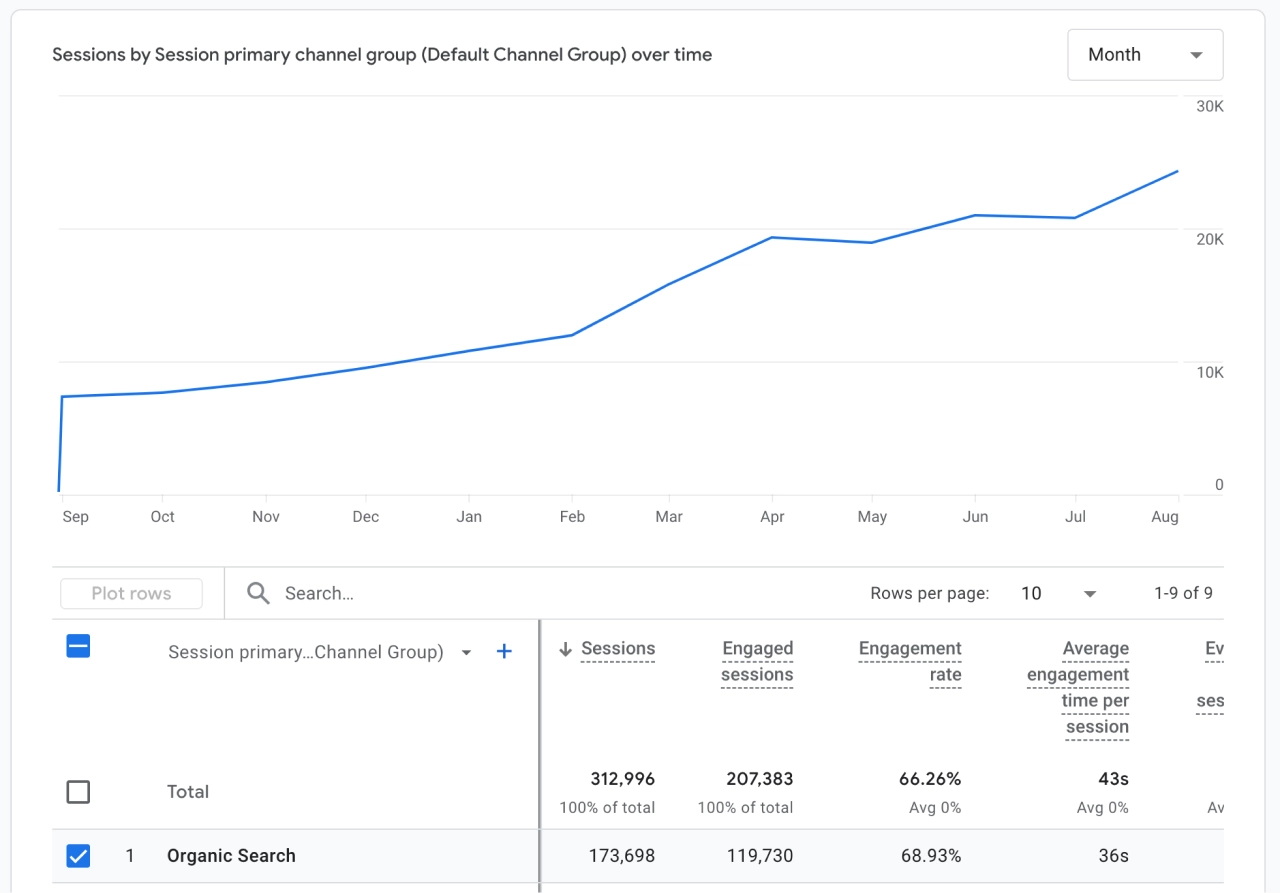
Tracking sessions over time in Google Analytics
Tools and methods for tracking organic traffic
To measure organic traffic:
Use Google Analytics to track the number of visitors coming from organic search
Analyze traffic trends over time to identify patterns and growth
Leverage Google Search Console to segment organic traffic by pages or queries to understand which content performs best and the keywords each piece of content ranks for
CAA Pro Tip: Don't just focus on quantity; pay attention to the quality of both your keywords and organic traffic. Look at what queries your content is ranking for and onsite metrics like time on site and pages per session to ensure you're creating relevant content for your target terms.
KPI #2: Keyword Rankings
Tracking keyword positions
Your keyword rankings directly impact your visibility in search results. Monitoring these positions helps you understand how well your content is performing for target keywords and identify opportunities for improvement.
Strategies for improving keyword rankings
To improve your keyword rankings:
Conduct regular keyword research to identify new opportunities
Optimize your content for target keywords, including title tags, meta descriptions, URLs, headers, and body text
Create high-quality, relevant content that addresses user intent
Build quality backlinks to increase your site's authority
KPI #3: Click-Through Rate (CTR)
How CTR impacts SEO performance
Your click-through rate is the percentage of users who click on your search result after seeing it.
A high CTR signals to search engines that your result is relevant and valuable to users, potentially leading to improved rankings; this is the engagement part of the equation.
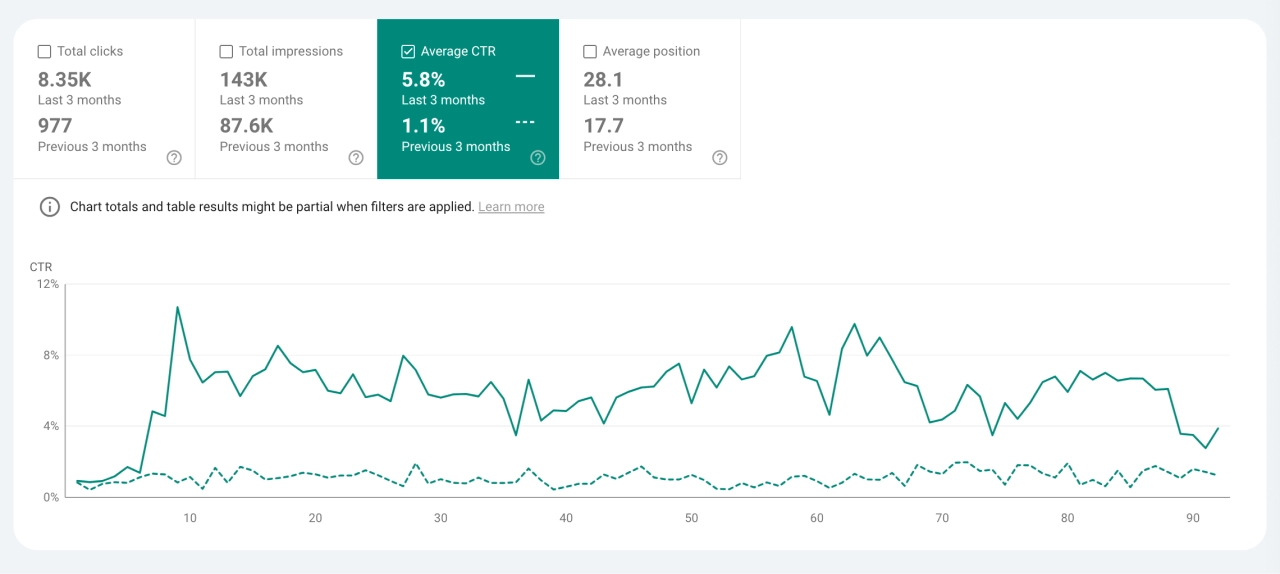
Measuring Click Through Rate
Tips for improving your dispensary's CTR
To increase your CTR:
Craft compelling title tags and meta descriptions that accurately reflect your content
Use schema markup to enhance your search snippets with rich results
Target long-tail keywords that have higher intent and less competition
A/B test your meta titles and descriptions to find what resonates best with your audience
CAA Pro Tip: A low CTR can also be a function of position. The lower in the Search Engine Results Page (SERP) your content is, the less likely it is to be clicked. One option is to explore longer-tail, less competitive variations of the content that you might be more likely to rank for.
KPI #4: Bounce Rate
What bounce rate tells you about user engagement
Bounce rate is the percentage of visitors who leave your site after viewing only one page. A high bounce rate can indicate that your content isn't meeting user expectations or that your site has usability issues.
Techniques for reducing bounce rate and improving user experience
To lower your bounce rate:
Ensure your content matches the user's search intent
Improve your site's loading speed (we'll discuss this more in KPI #5)
Use clear and compelling calls-to-action (CTAs) to encourage further exploration
Implement an intuitive site navigation structure
Optimize your site for mobile devices
Pro Tip: A "good" bounce rate can vary by industry and page type. For dispensaries, aim for a bounce rate below 60% for informational pages and below 40% for product pages. On the other hand, location pages would be expected to have a high bounce rate given that most users will likely exit after getting information like an address or phone number.
KPI #5: Page Load Speed
The impact of page speed on SEO and user experience
Page speed is crucial for both SEO and user experience. Slow-loading pages can lead to higher bounce rates, lower engagement, and potentially lower search rankings.
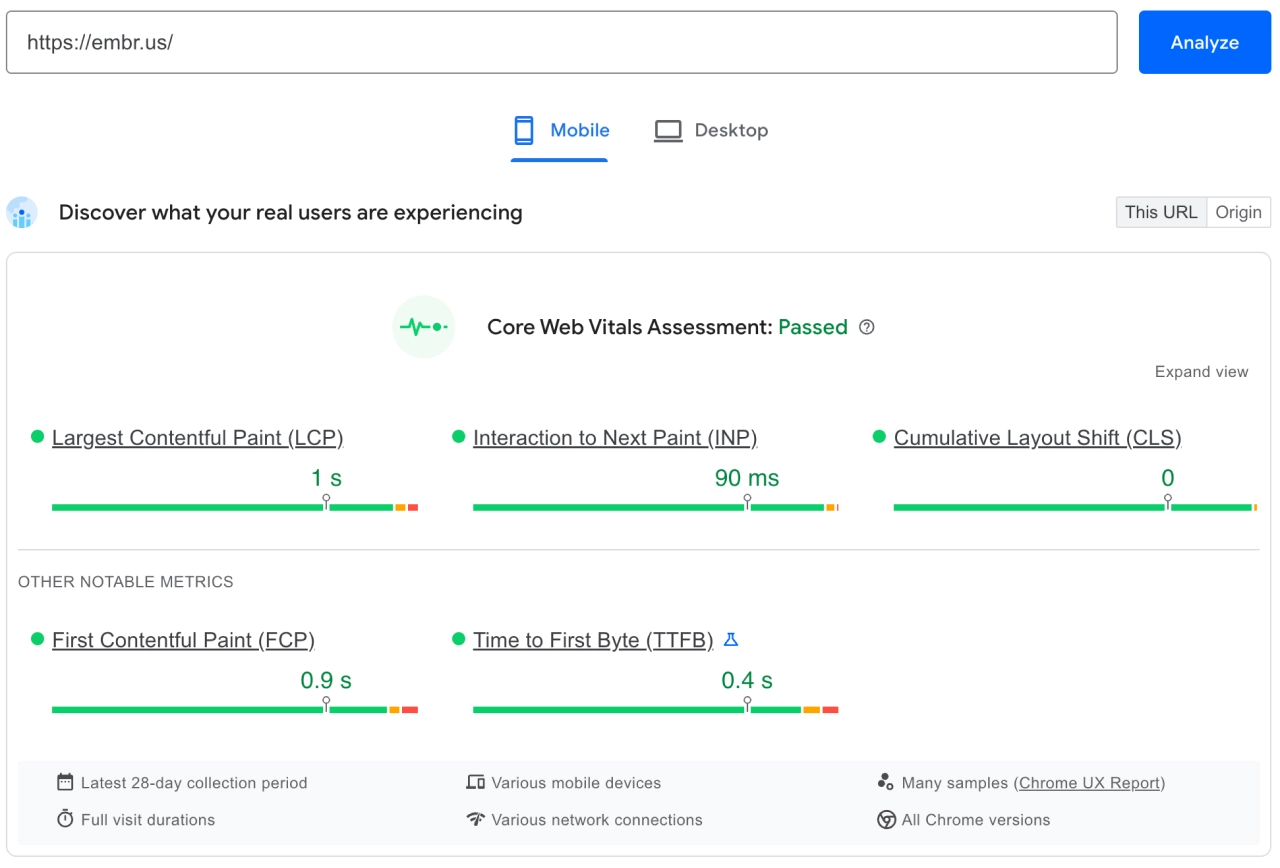
Google Page Speed Insights
Tools and strategies for optimizing page load times
To improve your page speed:
Use Google's PageSpeed Insights tool to identify specific areas for improvement
Optimize images by compressing them and using appropriate file formats
Leverage browser caching to store static files
Minify CSS, JavaScript, and HTML
Consider using a Content Delivery Network (CDN) for faster content delivery
KPI #6: Backlink Profile
Why backlinks matter for dispensary SEO
Backlinks are still a crucial ranking factor in Google's algorithm. They act as "votes of confidence" from other websites, signaling to search engines that your content is valuable and trustworthy.
Measuring and improving your backlink profile
To enhance your backlink profile:
Use tools like Ahrefs or Moz to monitor your backlink growth and quality
Focus on earning links from authoritative cannabis industry websites
Create link-worthy content such as industry reports, infographics, or comprehensive guides
Engage in digital PR to earn mentions and links from reputable publications
Regularly audit your backlink profile to identify and disavow any toxic links
KPI #7: Local SEO Metrics
Key local SEO indicators for dispensaries
For brick-and-mortar dispensaries, local SEO is crucial. Key metrics to track include:
Google Business Profile (GBP) views and actions
Local pack rankings for relevant keywords
Citation consistency across the web
Quantity and quality of customer reviews

Tracking reputation, profile, and citations with BrightLocal
Improving local search visibility
To boost your local SEO:
Optimize your Google Business Profile with accurate information and regular posts
Encourage satisfied customers to leave reviews on Google and other platforms
Ensure NAP (Name, Address, Phone) consistency across all online directories
Create location-specific content on your website
KPI #8: Mobile Traffic and Performance
The importance of mobile optimization for dispensaries
With Google's shift to mobile-first indexing, having a mobile-friendly website is no longer optional. Statista reported over 63% of searches are now performed on mobile devices.
Tracking and improving mobile SEO metrics
To enhance your mobile SEO:
Use Google Analytics to track mobile traffic and engagement metrics
Ensure your website is responsive and provides a seamless mobile experience
Optimize for mobile-specific ranking factors like page speed and mobile-friendliness
Use Google's Mobile-Friendly Test tool to identify and fix mobile usability issues
KPI #9: Conversion Rate
Defining and measuring conversions for dispensaries
Conversions can vary depending on your business goals but might include:
Online orders or reservations
Newsletter or loyalty sign-ups
"Get directions" clicks
Phone calls
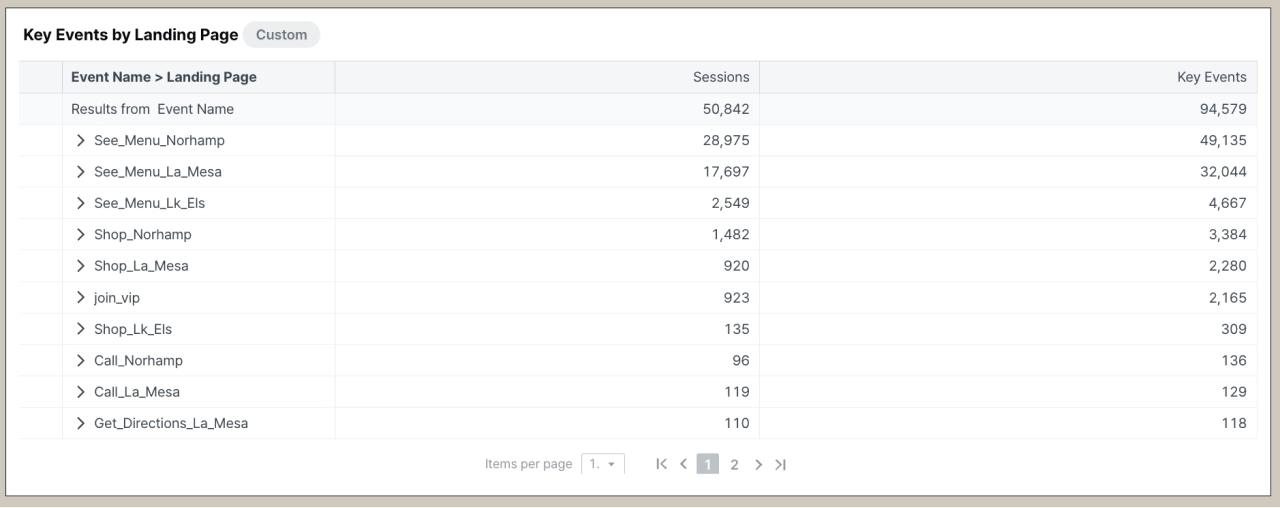
Landing page sessions with Adriel BI
Techniques for improving SEO-driven conversions
To boost your conversion rate:
1. Set up goal tracking in Google Analytics to measure specific conversion actions
2. Optimize your landing pages for relevant keywords and user intent
3. Use clear and compelling CTAs throughout your site
4. Implement A/B testing to refine your conversion optimization strategy
5. Ensure a smooth user experience, especially on high-value pages
Pro Tip: Don't forget to track micro-conversions, such as menu views or business address clicks, indicating user engagement and potential future conversions.
KPI #10: Return on Investment (ROI)
Calculating SEO ROI for dispensaries
Measuring the ROI of your SEO efforts helps justify your investment and guide future strategy. To calculate SEO ROI:
ROI = (Gain from Investment - Cost of Investment) / Cost of Investment
Strategies to maximize your SEO investment
To improve your dispensary’s SEO ROI:
Focus on high-value keywords that drive qualified traffic
Prioritize efforts that have the most significant impact on your bottom line; typically, this means having a local focus around navigational and transactional keyword searches
Continuously optimize your conversion funnel to maximize the value of your organic traffic
Leverage automation and tools to streamline your SEO processes
Tracking SEO KPIs
Essential tools for monitoring dispensary SEO performance
To effectively track your SEO KPIs, consider using:
Google Analytics for traffic and engagement metrics
Google Search Console for search performance data
SEMrush or Ahrefs for keyword tracking and competitive analysis
Local SEO tools like BrightLocal for Local Search Grid and Rank Tracker
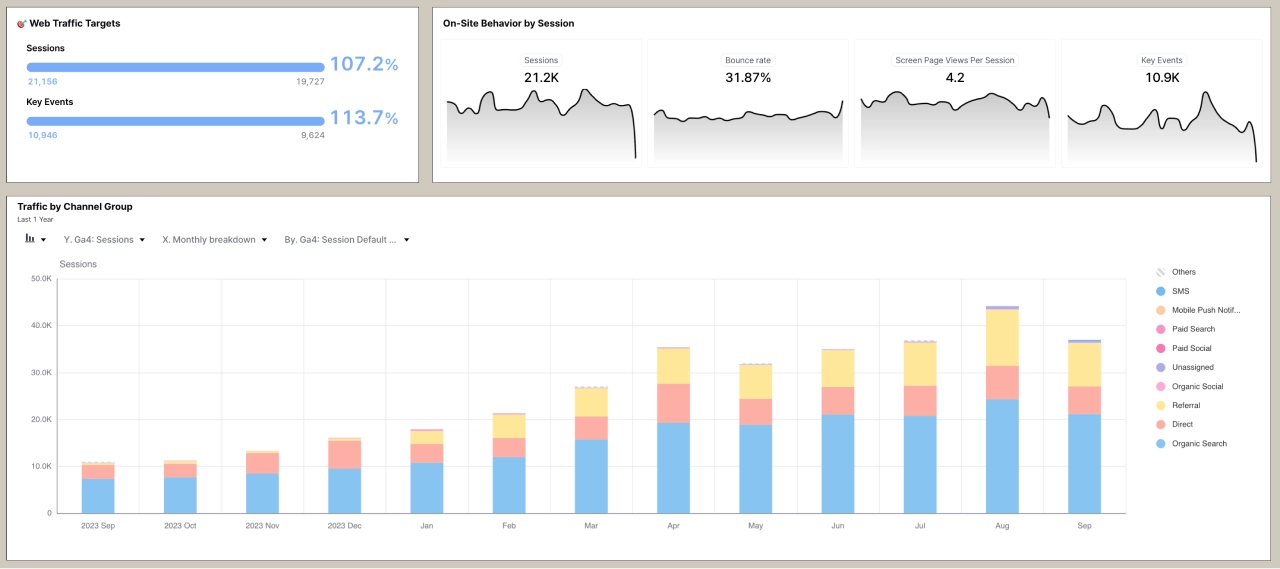
Adriel Local SEO
Creating a KPI dashboard for easy tracking and reporting
Develop a custom dashboard that consolidates your key metrics for easy monitoring and reporting. This can help you quickly identify trends and make data-driven decisions to improve your SEO performance.
Leveraging KPIs to Drive Dispensary Growth
By consistently tracking and analyzing these 10 essential SEO KPIs, you'll gain valuable insights into your dispensary's online performance and identify opportunities for growth. Remember, SEO is an ongoing process, and these metrics should guide your strategy as you continue to optimize and improve your digital presence.
Implementing a robust cannabis SEO strategy based on these KPIs can significantly impact your dispensary's visibility, traffic, and ultimately, your bottom line.
However, staying on top of the latest SEO trends and algorithm updates in the ever-changing cannabis industry can be challenging.
That's where we come in. At Cannabis Ad Agency, we specialize in helping dispensaries like yours navigate the complex world of SEO and digital marketing.
Our team of experts can help you implement and monitor dispensary SEO KPIs, develop tailored strategies to improve your performance and drive real results for your business.
Ready to improve your dispensary's SEO? Contact us today for a free consultation and discover how we can help you outrank your competitors and corner your local cannabis market.
FAQs About Dispensary SEO KPIs
1. How often should I review my SEO KPIs?
We recommend reviewing your KPIs at least monthly, with more frequent checks on critical metrics like organic traffic and conversions.
2. What's the most important KPI for dispensary SEO?
While all these KPIs are important, organic traffic and conversions are often the most crucial as they directly impact your bottom line.
3. How long does it take to see improvements in these KPIs?
SEO is a long-term strategy. While some changes can show results in a few weeks, significant improvements typically take 3-6 months or more.
4. How do I track competitor performance for these KPIs?
Tools like SEMrush and Ahrefs can provide insights into competitor rankings, traffic, and backlink profiles. For local SEO, tools like BrightLocal can help monitor competitor review scores and citation consistency.
Looking for Local SEO Services?
GET STARTEDTable of Contents
Why Tracking Dispensary SEO Matters<KPI #1: Organic TrafficKPI #2: Keyword RankingsKPI #3: Click-Through Rate (CTR)KPI #4: Bounce RateKPI #5: Page Load SpeedKPI #6: Backlink ProfileKPI #7: Local SEO MetricsKPI #8: Mobile Traffic and PerformanceKPI #9: Conversion RateKPI #10: Return on Investment (ROI)Tracking SEO KPIsFAQs About Dispensary SEO KPIs
